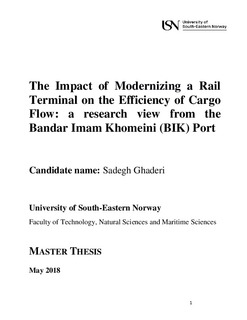The Impact of Modernizing a Rail Terminal on the Efficiency of Cargo Flow: a research view from the Bandar Imam Khomeini (BIK) Port
Master thesis
Permanent lenke
http://hdl.handle.net/11250/2638308Utgivelsesdato
2018Metadata
Vis full innførselSamlinger
Sammendrag
This study proposes some approaches regarding the importance of modernizing rail terminal on the efficiency of cargo flow at Bandar Imam Khomeini (BIK)1 port. It is one of the most important ports on the Persian Gulf and it has provided processing services for cargo owners over decades. However, one of the port’s main shortcomings is the lack of an efficient railway transportation infrastructure. The railway system is old and it surpassed by the current technology and infrastructure adopted for the border port facilities. Moreover, the poor coordination among rail system and other players creates confusion among cargo owners. Some of the significant challenges include the lack of a particular terminal that connects to some of the major companies that use the port. Consequently, it affects the efficiency of cargo flow and the potential increase in the port’s throughput. This project investigates whether modernizing rail terminal and adopting a new railway technology can improve the efficiency of cargo flow at the BIK port.
The thesis undertakes a mixed research strategy that incorporates both qualitative and quantitative research methodologies. The results of the study show that modernized railway infrastructure at the BIK port improves the efficiency of cargo flow at the port. Despite the cheaper costs associated with rail transportation mode, modernizing it will not cause a major decline in the use of trucks. This can be explained by unique advantages that the latter provides. The study finds that modernizing the railway infrastructure has strategic advantages for the efficiency of cargo flow and the competitiveness of the port at the BIK port.
